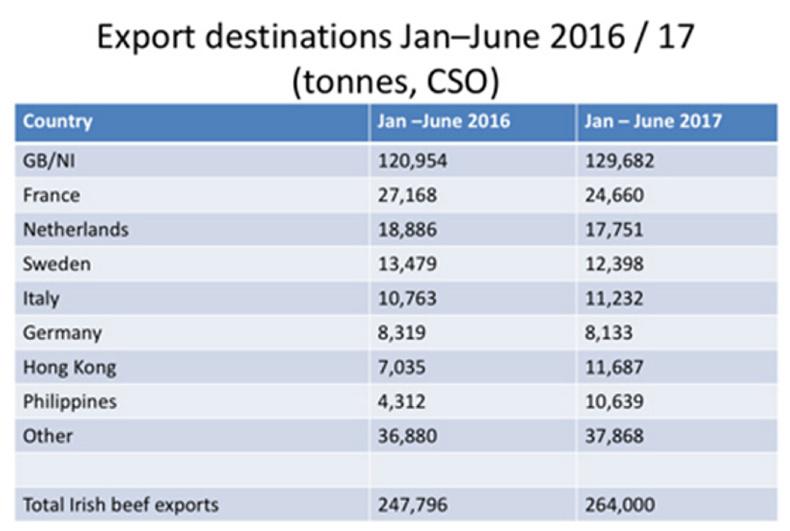Ireland exports 90% of all beef produced, with the UK being the most important market, taking half of all sales.
Traditionally, most of the rest was exported to other EU countries, with about 5% sold outside the EU to what are known as third countries.
However, this pattern changed significantly in the first six months of this year compared with the first half of last year.
Despite the collapse in the value of sterling against the euro, sales to the UK remained consistent with the first half of last year.
Export figures
Overall, Ireland exported 264,000t of beef in the first six months of this year compared with just under 248,000t for the same period last year.
This reflects the extra 41,000 head of cattle killed in the first half of this year compared with the first half of last year, a 5% increase.
The UK took 129,682t of beef, over 8,000t more than last year despite the collapse in the value of sterling against the euro.

What is noticeable, however, is that all the main markets in mainland Europe were down in the first half of the year despite more beef being available for sale.
France is down the most, probably reflecting the switch by many French retailers to exclusively French beef following farmer protests in 2016.
That market is down over 2,500t from 27,168t to 24,660 for the first six months of this year.
Asia
As well as the UK taking more Irish beef this year, the other major growth market has been Asia. Hong Kong has jumped from taking 7,035t in the first half of 2016 to 11,687t for the same period this year.
The market that has shown the most dramatic increase, however, has been the Philippines.
In the first half of 2016, it took 4,312t of Irish beef but this surged in the first half of this year to 10,639t.
This has proved to be an extremely valuable market for lower-value manufacturing beef and will also be a useful addition to the portfolio of markets for Northern Ireland and Scotland who just obtained approval to supply recently.
USA
The USA, despite high-profile ministerial promotion efforts, remains a disappointing market, taking just 685t of beef in the first six months of this year which is down on the already low volume exported there in the first half of 2016, which was 968t.
The securing of approval for manufacturing beef access to the USA in July 2016 hasn’t had any positive impact of sales to that market.
These CSO figures for the first half of 2016 show that market destinations for beef are extremely fluid and just how robust the trade with the UK is in spite of currency difficulties.
Also, it demonstrates a snapshot of markets at a particular time. Just because a market isn’t performing currently, doesn’t mean that will always be the way.
Hence the importance of the Government continuing its efforts to open new markets. It is by having options that the best value is obtained for Irish beef.
Read more
US-UK trade would impact farmers
'Current carcase classification system needs an upgrade'
Ireland exports 90% of all beef produced, with the UK being the most important market, taking half of all sales.
Traditionally, most of the rest was exported to other EU countries, with about 5% sold outside the EU to what are known as third countries.
However, this pattern changed significantly in the first six months of this year compared with the first half of last year.
Despite the collapse in the value of sterling against the euro, sales to the UK remained consistent with the first half of last year.
Export figures
Overall, Ireland exported 264,000t of beef in the first six months of this year compared with just under 248,000t for the same period last year.
This reflects the extra 41,000 head of cattle killed in the first half of this year compared with the first half of last year, a 5% increase.
The UK took 129,682t of beef, over 8,000t more than last year despite the collapse in the value of sterling against the euro.

What is noticeable, however, is that all the main markets in mainland Europe were down in the first half of the year despite more beef being available for sale.
France is down the most, probably reflecting the switch by many French retailers to exclusively French beef following farmer protests in 2016.
That market is down over 2,500t from 27,168t to 24,660 for the first six months of this year.
Asia
As well as the UK taking more Irish beef this year, the other major growth market has been Asia. Hong Kong has jumped from taking 7,035t in the first half of 2016 to 11,687t for the same period this year.
The market that has shown the most dramatic increase, however, has been the Philippines.
In the first half of 2016, it took 4,312t of Irish beef but this surged in the first half of this year to 10,639t.
This has proved to be an extremely valuable market for lower-value manufacturing beef and will also be a useful addition to the portfolio of markets for Northern Ireland and Scotland who just obtained approval to supply recently.
USA
The USA, despite high-profile ministerial promotion efforts, remains a disappointing market, taking just 685t of beef in the first six months of this year which is down on the already low volume exported there in the first half of 2016, which was 968t.
The securing of approval for manufacturing beef access to the USA in July 2016 hasn’t had any positive impact of sales to that market.
These CSO figures for the first half of 2016 show that market destinations for beef are extremely fluid and just how robust the trade with the UK is in spite of currency difficulties.
Also, it demonstrates a snapshot of markets at a particular time. Just because a market isn’t performing currently, doesn’t mean that will always be the way.
Hence the importance of the Government continuing its efforts to open new markets. It is by having options that the best value is obtained for Irish beef.
Read more
US-UK trade would impact farmers
'Current carcase classification system needs an upgrade'







 This is a subscriber-only article
This is a subscriber-only article










SHARING OPTIONS: